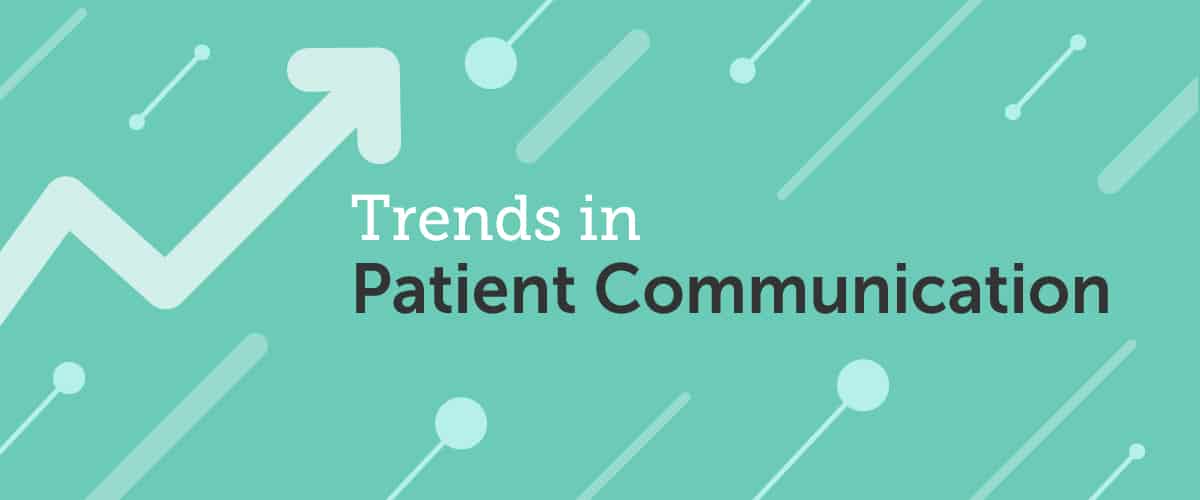Home / Blog /
Patient-Engagement Technology Dominates Healthcare IT Trends for 2020

Patient-Engagement Technology Dominates Healthcare IT Trends for 2020
5 Healthcare IT Trends That Put Patients at the Center of Care
With 2020 now in full swing, this new year promises abundant advancements across a broad swath of Healthcare technology. One major healthcare IT trend emerging in 2020 involves technologies that help clinical staff instantly and easily engage patients at key points in their healthcare journey from pre-surgery instructions to follow-up conversations after a hospital stay.
While greater sharing of patient data, easier access to care, more transparency into price, and overall patient satisfaction were all hot trends in 2019, industry experts expect the patient experience to go digital this year.
“Hospitals and physician practices are still in the early stages of the digital transformation into ‘real-time health systems.’” said Gartner analyst Gregg Pessin in a recent article published in ZDNet. Gregg also predicted that these “‘real-time healthcare delivery organizations’ will expand the use of automation, analytics, location and condition sensing, event-driven technologies, interoperability, and mobility.”
Healthcare IT Trend #1 – Healthcare organizations will empower patients to take a more active role in their health and wellness
In the transition to value-based care, providers are expected to deliver care more proactively, rather than reactively and place more focus on prevention of chronic disease. In this new environment, it is critical for patients to take a more active role in their health and wellness. Technologies that empower patients to engage with their healthcare providers at key points in their patient journey will be critical.
For example, in its Health Trends Report 2020, CVS shares how “they used data to determine when to send text messages to patients with a handful of chronic conditions, including chronic myeloid leukemia and rheumatoid arthritis. The messages contained information about side effects and symptom management, timed to arrive when the information would have the greatest effect on behavior. Results showed that participants were up to 6.3 percent more likely to refill prescriptions and achieve optimal medication adherence during these trials.”
Healthcare IT Trend #2 – Providers will look to technology solutions for new ways to engage and retain patients as healthcare costs rise
Patients who are bearing the brunt of rising healthcare costs will continue to look elsewhere for care options. Options like crowdsourcing sites and medical tourism for more expensive surgeries will become even more popular for U.S. patients.
To retain patients, providers will “implement savvier solutions… such as telehealth visits or new ways of engaging with patients across their care journey to help them stay on top of their health and wellbeing,” predicted Dr. Tashfeen Ekram, Chief Medical Officer and Co-founder at Luma Health, in an article in HIT Consultant.
Healthcare IT Trend #3 – Finding balance between increased access to care and potential physician and nurse burnout
Technology is necessary for continued innovation in the way patients experience healthcare, however, there is a risk of clinician burnout. With patients having more access to their care providers, several experts, including Hal Wolf, HIMSS president and CEO, encourage a thoughtful approach as healthcare ventures into this new territory.
“There is recognition that email and telehealth, for example, open new channels that reflect previously suppressed demand by the patient for more consistent and accessible communication,” said Hal in a recent HIMSS post. “To support the new channels, the workflow and accountabilities of clinicians need to be adjusted, or the days will get longer and work-life balance will suffer further in a losing game of personnel supply and demand.”
A Better Way to Communicate with Patients
|
 |
Healthcare IT Trend #4 – Patients will drive healthcare to finally cut the cord from 1970’s technology
A recent article in Patient Privacy News cautions that fax machines actually pose a risk with a long list of breaches caused by sending patient records to the wrong fax number. Other researchers have found risks to patient data itself, including vulnerabilities in the devices and data left on machines at the end of the product lifecycle. The Centers of Medicare and Medicaid Services has called for an end to fax machine use in the healthcare sector by 2020.
While these are all very good reasons to stop using old tech, the real driver for healthcare organizations will be patient preferences. The typical patient doesn’t have a pager or a fax machine and many don’t even have landline phones. As healthcare communication extends beyond just internal conversations to include the patient, healthcare organizations will move further away from 1970’s technology and finally cut the cord.
Healthcare IT Trend #5 – Healthcare will move towards more of an Amazon-like experience
Patients in the U.S. have sadly come to expect inefficiencies in healthcare delivery – long Emergency Department wait times, transfer delays, slow lab result, poor clinician follow-up, and much more are sadly considered the norm. But patient tolerance levels are becoming much lower as they experience instant, seamless communication and transactions in other industries that make healthcare look decades behind.
“We really believe that we need to be more digital in our consumer engagement, that in order to reach people we need to be as responsive and easy to access as Amazon and other digital platform based organizations,” said Mikelle Moore, the senior vice president for community health at Intermountain Healthcare, in an interview with Patient Engagement HIT.
As patient communication takes center stage as a way for healthcare organizations to deliver quality care more affordably, make sure you’re prepared. TigerConnect is happy to demonstrate its patient messaging solution upon request. If you’d like to see patient messaging (a.k.a. TigerConnect Patient Engagement) in action, request a standard demo today!
Will O'Connor M.D., CMIO at TigerConnect
Will O’Connor, M.D. is the Chief Medical Information Officer at TigerConnect. As a physician executive with more than 20 years of healthcare experience, Will is a passionate advocate for rapid advancement across the healthcare industry.
Tags: Healthcare IT Trend








